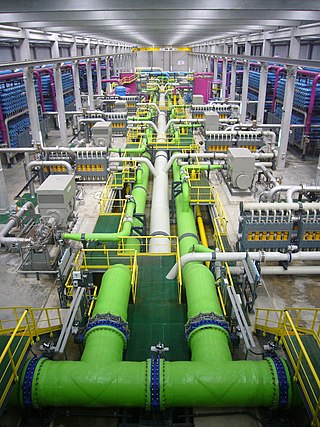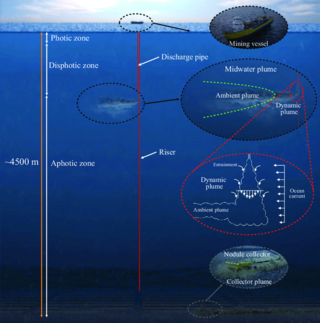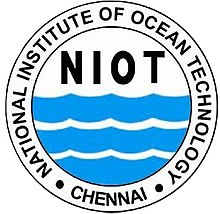
The International Seabed Authority (ISA) is a Kingston, Jamaica-based intergovernmental body of 167 member states and the European Union established under the 1982 UN Convention on the Law of the Sea (UNCLOS) and its 1994 Agreement on Implementation. The ISA's dual mission is to authorize and control development of mineral related operations in the international seabed considered the "common heritage of all mankind" and also protect the ecosystem of the seabed, ocean floor and subsoil in "The Area" beyond national jurisdiction. The ISA is to safeguard the international deep sea, the waters below 200 meters or 656 feet, where photosynthesis is hampered by inadequate light. Governing approximately half of the total area of the world's oceans, the ISA is to exercise oversight of activities that might threaten biological diversity and harm the marine environment. The Authority operates as an autonomous international organization with its own Assembly, Council and Secretariat.
Ocean thermal energy conversion (OTEC) is a renewable energy technology that harnesses the temperature difference between the warm surface waters of the ocean and the cold depths to produce electricity. It is a unique form of clean energy generation that has the potential to provide a consistent and sustainable source of power. Although it has challenges to overcome, OTEC has the potential to provide a consistent and sustainable source of clean energy, particularly in tropical regions with access to deep ocean water.

Desalination is a process that takes away mineral components from saline water. More generally, desalination refers to the removal of salts and minerals from a target substance, as in soil desalination, which is an issue for agriculture. Saltwater is desalinated to produce water suitable for human consumption or irrigation. The by-product of the desalination process is brine. Desalination is used on many seagoing ships and submarines. Most of the modern interest in desalination is focused on cost-effective provision of fresh water for human use. Along with recycled wastewater, it is one of the few rainfall-independent water resources.

Polymetallic nodules, also called manganese nodules, are mineral concretions on the sea bottom formed of concentric layers of iron and manganese hydroxides around a core. As nodules can be found in vast quantities, and contain valuable metals, deposits have been identified as a potential economic interest. Depending on their composition and autorial choice, they may also be called ferromanganese or polymetallic nodules. Ferromanganese nodules are mineral concretions composed of silicates and insoluble iron and manganese oxides that form on the ocean seafloor and terrestrial soils. The formation mechanism involves a series of redox oscillations driven by both abiotic and biotic processes. As a byproduct of pedogenesis, the specific composition of a ferromanganese nodule depends on the composition of the surrounding soil. The formation mechanisms and composition of the nodules allow for couplings with biogeochemical cycles beyond iron and manganese. The high relative abundance of nickel, copper, manganese, and other rare metals in nodules has increased interest in their use as a mining resource.

The seabed is the bottom of the ocean. All floors of the ocean are known as 'seabeds'.

The National Institute of Oceanography, founded on 1 January 1966 as one of 38 constituent laboratories of the CSIR, is a self-governing research organisation in India that conducts scientific research and studies on the unique oceanographic features of the northern Indian Ocean. It is headquartered in Goa and has regional offices in Kochi, Mumbai, and Visakhapatnam.
Subsea technology involves fully submerged ocean equipment, operations, or applications, especially when some distance offshore, in deep ocean waters, or on the seabed. The term subsea is frequently used in connection with oceanography, marine or ocean engineering, ocean exploration, remotely operated vehicle (ROVs) autonomous underwater vehicles (AUVs), submarine communications or power cables, seafloor mineral mining, oil and gas, and offshore wind power.

Deep sea mining is the extraction of minerals from the ocean floor found at depths of 200 metres (660 ft) to 6,500 metres (21,300 ft). As of 2021, the majority of marine mining efforts were limited to shallow coastal waters, where sand, tin and diamonds are more readily accessible. It is a growing subfield of experimental seabed mining. Three types of deep sea mining have generated interest: polymetallic nodule mining, polymetallic sulfide mining, and cobalt-rich ferromanganese crusts. The majority of proposed deep sea mining sites are near polymetallic nodules or active and extinct hydrothermal vents at 1,400 to 3,700 metres depth. The vents create globular or "massive" sulfide deposits that contain valuable metals such as silver, gold, copper, manganese, cobalt, and zinc. The deposits are mined using hydraulic pumps or bucket systems that carry ore to the surface for processing.
The Ministry of Earth Sciences was formed on 29 January 2006 from a merger of the India Meteorological Department (IMD), the National Centre for Medium Range Weather Forecasting (NCMRWF), the Indian Institute of Tropical Meteorology, Pune (IITM), the Earth Risk Evaluation Centre (EREC) and the Ministry of Ocean Development.
Nii Allotey Odunton, a mining engineer from Ghana, was the Secretary-General of the International Seabed Authority, serving back to back four-year terms starting in 2009 and ending in 2017. He was succeeded by Michael W. Lodge.

ORV Sagar Nidhi is an ice-strengthened multidisciplinary vessel operated by the National Institute of Ocean Technology, India. It was constructed at Fincantieri, Italy. The 104-metre-long vessel has fully automatic diesel-electric propulsion equipped with dynamic positioning system, azimuth thrusters, and a winch to hoist 60 tonnes from a depth of 6,000 metres.
The Mallik Methane Hydrate Site is located in the Beaufort Sea, Canada.
Low-temperature thermal desalination (LTTD) is a desalination technique which takes advantage of the fact that water evaporates at lower temperatures at low pressures, even as low as ambient temperature. The system uses vacuum pumps to create a low pressure, low-temperature environment in which water evaporates even at a temperature gradient of 8 °C (14 °F) between two volumes of water. Cooling water is supplied from deep sea depths of as much as 600 metres (2,000 ft). This cold water is pumped through coils to condense the evaporated water vapor. The resulting condensate is purified water.
India has a long coastline of 7517 km marked along by numerous estuaries and gulfs which makes it attractive for the development of marine energy projects. India's wave power potential is around 40-60GW. However, compared to the developments in other renewable energy technologies, ocean energy technologies like wave and tidal are in their nascent stages of development in India.
Underwater domain awareness (UDA) is the aspect of maritime domain awareness focused on the underwater sector, including, from a security perspective, sea lines of communication (SLOC), coastal waters and varied maritime assets with reference to hostile intent and the proliferation of submarine and mine capabilities intended to limit access to the seas and littoral waters. The military requirement is not the only motivation for undersea domain awareness. The earth's undersea geophysical activities as they relate to the well-being of humans is also relevant, as monitoring such activities can provide vital clues to minimize the impact of devastating natural disasters.

Praveen Linga PhD, a chemical engineer, is a professor at the National University of Singapore's Department of Chemical and Biomolecular Engineering. He is an expert in clathrate hydrates or gas hydrates. He is also the co-founder of NewGen Gas Pte Ltd, a spin-off company that specialises in solidified natural gas (SNG) technology via clathrate hydrates for natural gas storage and transport. He has been interviewed and has provided expert opinion and commentary in the media.
Deep Ocean mission is an Indian initiative to undertake the deep ocean exploration focused on India's exclusive economic zones and continental shelf. The program will consist of various crewed and uncrewed submersibles exploring the sea bed. One of the primary aims of the mission is to explore and extract polymetallic nodules, which are composed of minerals like manganese, nickel, cobalt, copper and iron hydroxide. The metals can used in the manufacturing of electronic devices, smartphones, batteries and solar panels.
Seabed mining, also known as Seafloor mining is the recovery of minerals from the seabed by techniques of underwater mining. The concept includes mining at shallow depths on the continental shelf and deep-sea mining at greater depths associated with tectonic activity, hydrothermal vents and the abyssal plains. While there is opportunity for economical mineral extraction at areas of high concentration of valuable minerals, there is also significant risk of ecological damage of unknown and to some degree, unpredictable, extent. Increasing requirements for minerals and metals, largely for use in the technology sector, has led to renewed interest in exploitation of seabed mineral resources, including massive polymetallic sulfide deposits around hydrothermal vents, cobalt-rich crusts on the sides of seamounts and fields of manganese nodules on the abyssal plains.
Matsya 6000 is an Indian crewed deep-submergence vehicle intended to be utilised for deep-sea exploration of rare minerals under the Deep Ocean mission. Currently under development, the vehicle would consist of a titanium alloy sphere of 80mm thickness along with a diameter of 2.1m which can withstand the pressure of 600 bar.

M.V. Ramana Murthy is an Indian Scientist and Engineer, Mission Director for Deep Ocean mission and Director at National Centre for Coastal Research (NCCR), Ministry of Earth Sciences (MoES), Government of India.









